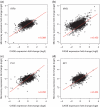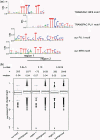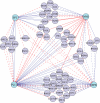Building promoter aware transcriptional regulatory networks using siRNA perturbation and deepCAGE
- PMID: 20724440
- PMCID: PMC3001087
- DOI: 10.1093/nar/gkq729
Building promoter aware transcriptional regulatory networks using siRNA perturbation and deepCAGE
Abstract
Perturbation and time-course data sets, in combination with computational approaches, can be used to infer transcriptional regulatory networks which ultimately govern the developmental pathways and responses of cells. Here, we individually knocked down the four transcription factors PU.1, IRF8, MYB and SP1 in the human monocyte leukemia THP-1 cell line and profiled the genome-wide transcriptional response of individual transcription starting sites using deep sequencing based Cap Analysis of Gene Expression. From the proximal promoter regions of the responding transcription starting sites, we derived de novo binding-site motifs, characterized their biological function and constructed a network. We found a previously described composite motif for PU.1 and IRF8 that explains the overlapping set of transcriptional responses upon knockdown of either factor.
Figures





Similar articles
-
The combination of gene perturbation assay and ChIP-chip reveals functional direct target genes for IRF8 in THP-1 cells.Mol Immunol. 2010 Aug;47(14):2295-302. doi: 10.1016/j.molimm.2010.05.289. Epub 2010 Jun 22. Mol Immunol. 2010. PMID: 20573402
-
PU.1 and IRF8 Modulate Activation of NLRP3 Inflammasome via Regulating Its Expression in Human Macrophages.Front Immunol. 2021 Apr 7;12:649572. doi: 10.3389/fimmu.2021.649572. eCollection 2021. Front Immunol. 2021. PMID: 33897697 Free PMC article.
-
IRF8 and IRF3 cooperatively regulate rapid interferon-β induction in human blood monocytes.Blood. 2011 Mar 10;117(10):2847-54. doi: 10.1182/blood-2010-07-294272. Epub 2011 Jan 12. Blood. 2011. PMID: 21228327
-
Early B-cell factor 1 (EBF1) is critical for transcriptional control of SLAMF1 gene in human B cells.Biochim Biophys Acta. 2016 Oct;1859(10):1259-68. doi: 10.1016/j.bbagrm.2016.07.004. Epub 2016 Jul 14. Biochim Biophys Acta. 2016. PMID: 27424222
-
PU.1/Interferon Regulatory Factor interactions: mechanisms of transcriptional regulation.Cell Biochem Biophys. 2000;33(2):127-48. doi: 10.1385/CBB:33:2:127. Cell Biochem Biophys. 2000. PMID: 11325034 Review.
Cited by
-
Selective Activation of Alternative MYC Core Promoters by Wnt-Responsive Enhancers.Genes (Basel). 2018 May 23;9(6):270. doi: 10.3390/genes9060270. Genes (Basel). 2018. PMID: 29882899 Free PMC article.
-
NanoCAGE: a high-resolution technique to discover and interrogate cell transcriptomes.Cold Spring Harb Protoc. 2011 Jan 1;2011(1):pdb.prot5559. doi: 10.1101/pdb.prot5559. Cold Spring Harb Protoc. 2011. PMID: 21205859 Free PMC article.
-
Automated workflow for preparation of cDNA for cap analysis of gene expression on a single molecule sequencer.PLoS One. 2012;7(1):e30809. doi: 10.1371/journal.pone.0030809. Epub 2012 Jan 30. PLoS One. 2012. PMID: 22303458 Free PMC article.
-
5' end-centered expression profiling using cap-analysis gene expression and next-generation sequencing.Nat Protoc. 2012 Feb 23;7(3):542-61. doi: 10.1038/nprot.2012.005. Nat Protoc. 2012. PMID: 22362160 Free PMC article.
-
SINCERITIES: inferring gene regulatory networks from time-stamped single cell transcriptional expression profiles.Bioinformatics. 2018 Jan 15;34(2):258-266. doi: 10.1093/bioinformatics/btx575. Bioinformatics. 2018. PMID: 28968704 Free PMC article.
References
-
- Lander ES, Linton LM, Birren B, Nusbaum C, Zody MC, Baldwin J, Devon K, Dewar K, Doyle M, FitzHugh W, et al. Initial sequencing, analysis of the human genome. Nature. 2001;409:860–921. - PubMed
-
- Carninci P, Kasukawa T, Katayama S, Gough J, Frith MC, Maeda N, Oyama R, Ravasi T, Lenhard B, Wells C, et al. The transcriptional landscape of the mammalian genome. Science. 2005;309:1559–1563. - PubMed
-
- Quackenbush J. Extracting biology from high-dimensional biological data. J. Exp. Biol. 2007;210(Pt 9):1507–1517. - PubMed
Publication types
MeSH terms
Substances
LinkOut - more resources
Full Text Sources
Miscellaneous

